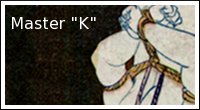SM and the Super Man
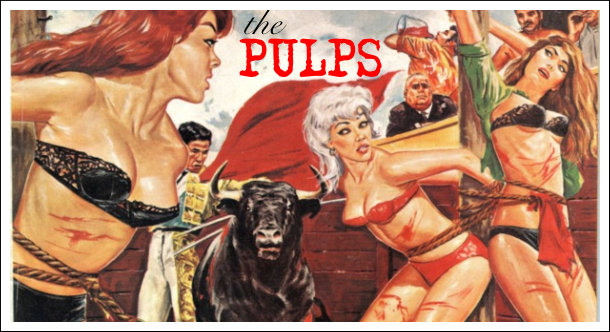
Before comic books, there were the salacious so-called detective magazines and men's adventure magazines. These were the original, the true pulp fiction masterpieces, before Tarantino came along. On the outside they flashed slick, provocative covers. On the inside, lurid stories, some by now-famous authors, were cranked out on cheap paper.
The pulp phenomenon in the US spanned the 1920s to the 1950s. The ascension of television is believed to have caused the decline in the popularity of the pulps.
In Japan, in the early years of the 20th century, there was the eroguro nansensu movement (erotic grotesque nonsense). The publications of that time were the predecessors of post-Word War II magazines such as Kitan Club.
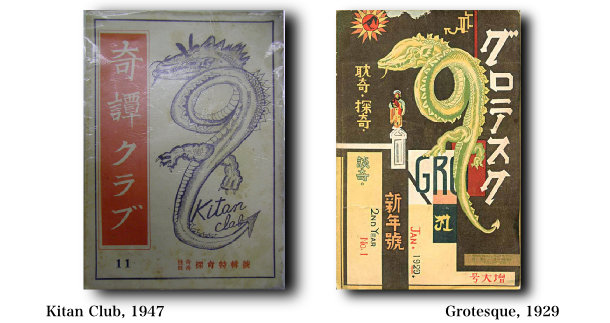
One of these publications was called, appropriately enough, Grotesque. It was published by Kitahara Hokumei in 1928, the very early days of the Showa Period.
Back in the US, the covers of many pulps featured near nudity, bondage and torture. For the connoisseur, the artists were masters of the genre and these long out-of-print books have become sought-after collectibles.
It's important to note that publications of this nature, including comic books, came under fire from the government in the 1950s. A world war had just been fought which, if you asked anyone, was waged to preserve freedom. And yet, what was seemingly tolerated in the 1930s became the subject of a book burning in the 1950s. Literally.
But let's go back in time a bit.
Comic books were an offshoot of the pulps. The publisher of such titles as Spicy Detective and Spicy Mystery was one Harry Donenfeld, an immigrant to the US from Romania at the age of five.
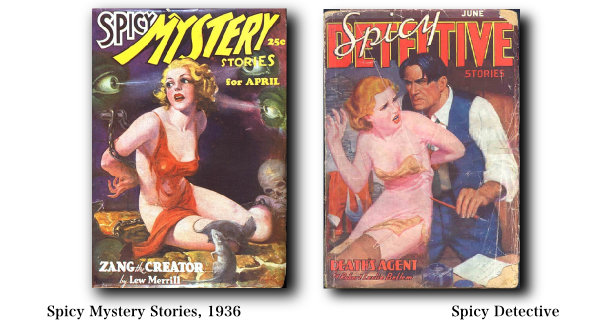
His family settled in New York City. By the time he had gotten married, the Great Depression was threatening. He and his wife opened a clothing store but it eventually succumbed to the economic chaos.
He then went to work as a salesman for his two elder brothers who were running a printing business. He was successful although at least one source speculates that the trucks coming in from Canada loaded with pulp paper contained a secret stowaway: illegal booze. You will remember that Prohibition was in effect, causing Al Capone, and perhaps Harry Donenfeld, to smile.

Similar European fare
When it came to business and Donenfeld, blood was not thicker than water and he eventually seized control of the printing company, forcing his brothers out.
It is reported that he set up several shell corporations. Perhaps this was to keep separate the sexy titles from the more wholesome fare. Perhaps it was to gain tax and postal rate advantages. Perhaps it was to confound anyone with a badge who might find a cover blurb such as "Lust Strangler" inappropriate.
Perhaps it was all of the above.
In 1935, an ex-military man by the name of Major Malcolm Wheeler-Nicholson started a comic book called New Fun. It was the first comic to contain all original material. Prior to that, pulps were merely reproducing comic strips that ran in daily newspapers. In 1937 he started another title called Detective Comics.

From Nights of Horror
Detective Comics is still with us today. It morphed into DC, the giant comic book company that brought into existence the well-known characters Superman and Batman.
Wheeler-Nicholson got into debt with his printer and was unable to pay his bill. Who was the printer? Harry Donenfeld. To make a long story short, Donenfeld wrested control of Wheeler-Nicholson's company, National Allied Publishing, away from him.
Around this time, two Cleveland, Ohio teenagers, writer Jerry Siegel and artist Joe Shuster, had created a character they called Superman. They shopped the character around to all the major publishers but it was repeatedly rejected.
In 1938 their luck changed and Superman finally saw the light of day in a comic book called Action Comics published by DC. Siegel and Shuster subsequently sold the rights to the character to Donenfeld's company for $130 US. Just for the record, this year a mint condition original of this issue of Action Comics featuring the debut of Superman sold at auction for $1 million US.
Siegel and Shuster did well for a few years off the character they had invented. Most of their income came from the Superman comic strip which was running in daily newspapers.
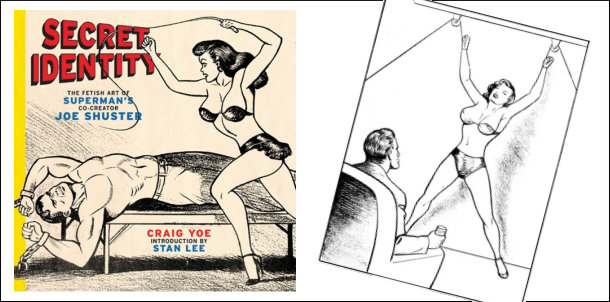
However, just like today, the popular character was marketed heavily and the bucks really started to roll in. There was a Superman radio show, for example, followed by a TV show. And the character was licensed for use to various product manufacturers. Having sold the rights, Siegel and Shuster did not share in this windfall. Their complaints fell on deaf ears and when their contracts came up for renewal, they were summarily dumped by DC.
Superman would continue on with different writers and artists.
Joe Shuster fell on hard times. At one point, it is reported he took a job as a delivery man to make ends meet. He died in 1992 in a Los Angeles nursing home.
That would pretty much be the end of the story except that, in 2009, a book was published titled, Secret Identity: The Fetish Art of Superman's Co-Creator Joe Shuster.
The premise of the book is that Joe Shuster, in the early 1950s, had illustrated a series of cheaply produced magazines called Nights of Horror. The artwork seems undeniably that of Shuster. Even the characters look shockingly familiar. Only, in Nights of Horror we have Lois Lane whipping Clark Kent and arch-villain Lex Luthor torturing Lois Lane. Superman's pal Jimmy Olsen even makes an appearance. The names, of course, were changed to protect the innocent.
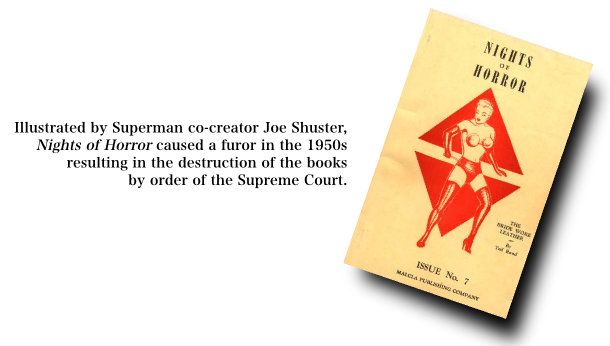
Stan Lee, the co-creator of the super hero Spider-Man, wrote an introduction to the book in which he assures us that Shuster drew these pictures out of financial desperation. Having seen several of the images from the book, I'm not so sure. It seems to me that Shuster probably had an interest in the subject of SM.
A correspondent to this blog makes the point that both reasons could be legitimate. Most assuredly. They are not mutually exclusive.
Joe Shuster had a sad descent into poverty but the saddest and most sordid part of the tale is that the US Supreme Court got involved in the case of Nights of Horror. Though Shuster remained anonymous, the publisher and printer were jailed and the Court actually ordered the destruction of the remaining copies of the publication.
But not all were put to the flame. Some survived to tell the story of a 1950s witch hunt, the nexus of comics and pulp fiction and what a costumed super hero was up to when he wasn't out saving the world.
KabukiJoe




